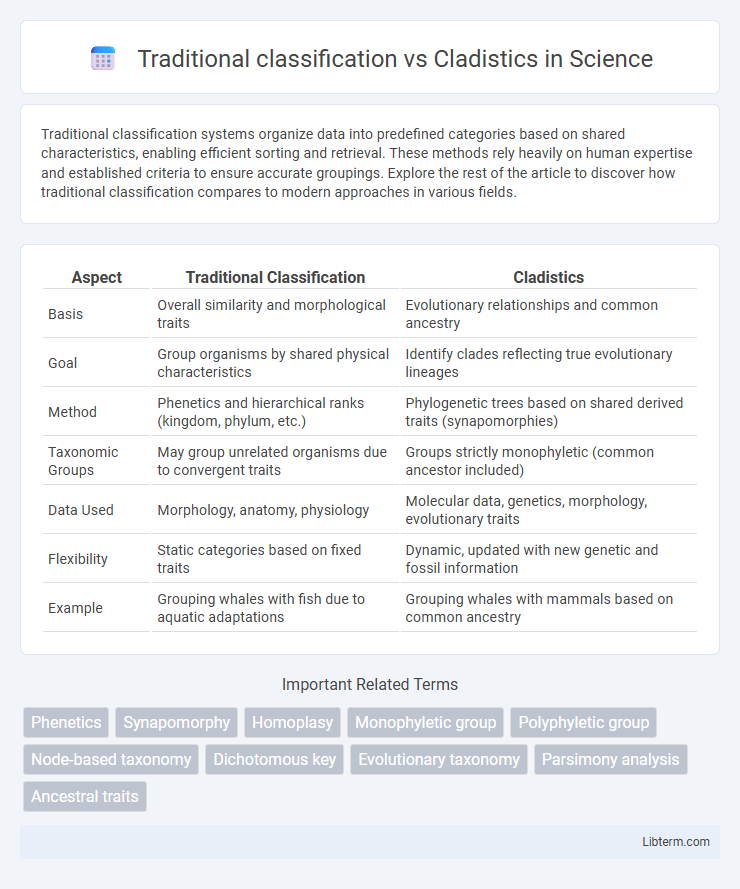Traditional classification systems organize data into predefined categories based on shared characteristics, enabling efficient sorting and retrieval. These methods rely heavily on human expertise and established criteria to ensure accurate groupings. Explore the rest of the article to discover how traditional classification compares to modern approaches in various fields.
Table of Comparison
| Aspect | Traditional Classification | Cladistics |
|---|---|---|
| Basis | Overall similarity and morphological traits | Evolutionary relationships and common ancestry |
| Goal | Group organisms by shared physical characteristics | Identify clades reflecting true evolutionary lineages |
| Method | Phenetics and hierarchical ranks (kingdom, phylum, etc.) | Phylogenetic trees based on shared derived traits (synapomorphies) |
| Taxonomic Groups | May group unrelated organisms due to convergent traits | Groups strictly monophyletic (common ancestor included) |
| Data Used | Morphology, anatomy, physiology | Molecular data, genetics, morphology, evolutionary traits |
| Flexibility | Static categories based on fixed traits | Dynamic, updated with new genetic and fossil information |
| Example | Grouping whales with fish due to aquatic adaptations | Grouping whales with mammals based on common ancestry |
Introduction to Biological Classification
Traditional classification groups organisms based on overall similarity and morphological traits, often relying on observable characteristics and hierarchical ranks like kingdom, phylum, and class. Cladistics classifies organisms by shared derived characteristics (synapomorphies) and evolutionary relationships, constructing cladograms that reflect common ancestry and divergence. Biological classification introduced systematic approaches to organize biodiversity, transitioning from phenetic methods to phylogenetic frameworks that emphasize lineage and genetic data.
Overview of Traditional Classification Systems
Traditional classification systems organize organisms based on observable morphological traits and overall similarity, often grouped into hierarchical categories such as kingdom, phylum, class, order, family, genus, and species. This approach relies heavily on phenotypic characteristics and can include subjective judgments about which traits are most important for classification. Traditional classification tends to emphasize practical identification and ease of use rather than evolutionary relationships or genetic data.
Fundamentals of Cladistics
Traditional classification organizes organisms based on overall similarities and differences, often relying on morphological traits and phenotypic characteristics, while cladistics emphasizes evolutionary relationships by grouping species according to shared derived characteristics (synapomorphies). The fundamentals of cladistics involve constructing phylogenetic trees called cladograms that represent hypotheses of common ancestry, focusing on monophyletic groups that include an ancestor and all its descendants. Cladistics uses algorithms, such as maximum parsimony or maximum likelihood, to infer evolutionary pathways and minimize homoplasy, thereby providing a more objective and testable framework for biological classification.
Key Differences Between Traditional Classification and Cladistics
Traditional classification groups organisms based on overall morphological similarities and hierarchical ranks like kingdom, phylum, and class, often relying on observable physical traits. Cladistics, in contrast, classifies organisms based on shared derived characteristics (synapomorphies) and evolutionary relationships, emphasizing common ancestry through cladograms or phylogenetic trees. Unlike traditional methods that may group unrelated species due to convergent traits, cladistics provides a more accurate reflection of evolutionary lineage by focusing on monophyletic groups.
Historical Development of Classification Methods
Traditional classification, rooted in Linnaean taxonomy from the 18th century, primarily grouped organisms based on morphological similarities and hierarchical ranks such as kingdom, phylum, and class. Cladistics emerged in the mid-20th century, pioneered by Willi Hennig, emphasizing evolutionary relationships and shared derived characteristics (synapomorphies) to construct phylogenetic trees. This shift from morphology-based taxonomy to cladistic analysis revolutionized systematics, providing a more objective and reproducible framework grounded in common ancestry and evolutionary history.
Importance of Evolutionary Relationships
Traditional classification organizes species based on shared physical traits, often overlooking deeper evolutionary connections. Cladistics emphasizes evolutionary relationships by grouping organisms according to common ancestry and derived characteristics, providing a more accurate reflection of lineage divergence. Understanding these evolutionary links is crucial for reconstructing the tree of life and predicting traits in related species.
Advantages of Cladistics over Traditional Classification
Cladistics offers a more precise method by grouping organisms based on shared derived characteristics, reflecting evolutionary relationships rather than superficial similarities used in traditional classification. This approach allows for the construction of phylogenetic trees that accurately depict lineage divergence and common ancestry. By emphasizing monophyletic groups, cladistics enhances the understanding of species' evolutionary history and improves the predictive power of biological classification systems.
Limitations and Criticisms of Each Approach
Traditional classification relies heavily on morphological similarities which can result in convergent evolution being misinterpreted as close relations, leading to polyphyletic groupings. Cladistics, while emphasizing evolutionary relationships through shared derived characteristics (synapomorphies), often faces criticism for its dependency on available genetic or morphological data which can be incomplete or ambiguous, causing unresolved phylogenies. Both approaches struggle with horizontal gene transfer and hybridization events that blur lineage distinctions, complicating the accurate reconstruction of evolutionary histories.
Applications in Modern Taxonomy
Traditional classification groups organisms based on shared physical traits and hierarchical ranks, which can lead to artificial groupings that do not reflect evolutionary relationships. Cladistics uses molecular data and shared derived characteristics to construct phylogenetic trees, providing more accurate evolutionary histories. Modern taxonomy increasingly favors cladistics for its ability to reveal genetic lineages and improve the classification of biodiversity.
Future Perspectives in Biological Classification
Future perspectives in biological classification emphasize integrating molecular data with traditional morphology-based methods to enhance evolutionary accuracy and phylogenetic resolution. Advances in genomics and bioinformatics enable cladistics to refine species relationships through large-scale DNA sequencing, promoting dynamic and data-driven taxonomies. Emerging techniques, such as machine learning applied to genetic and phenotypic datasets, may transform classical classification frameworks by enabling predictive and automated systematics.
Traditional classification Infographic

 libterm.com
libterm.com